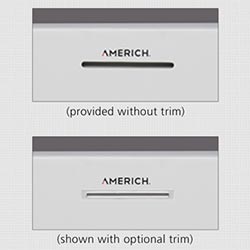

This may cause a clog in the condensate drain pan. For example, algae and mold usually grow in the condensate pan over time. Sometimes, a clog may appear in the condensate pan. Overflows occur when a clog in the line leads to the drain system.
Linear overflow drain cracked#
A cracked pan causes water pooling near the opening of the indoor component of your AC.
Linear overflow drain crack#
It is common for a plastic drain pan to crack after some time. The condensate pan may be made of either metal or plastic. It collects the water that drips from the evaporator coil within the air handler part of your AC system. The drip pan is located beneath the air handler. This is so because the big air conditioner processes large amounts of air. Large air conditioners produce lots of excess water than small air conditioning systems.

The size and nature of the air conditioning system influence the condensate amount. You may have as much as 20 gallons of water from the system daily. If you live in humid areas, expect a large amount of water to drain from your air conditioning system every day. For example, you may have only five gallons of water from the external drain pipe. If you live in a dry climate, expect a small amount of water to drain from your conditioning system every day. One of the most important factors is the climate. The actual amount of water that should be draining from your air conditioner varies.

How much Water should Drain from the Air Conditioner? A clogged drain line causes water to accumulate and overflow from the drain pan. If you see stagnant water in your drain pan, the chances are that you have a clogged condensate line. If the weather is less humid, the amount of excess water that drips from the line should be less. This amount may increase when the weather is humid. It is the water that drips from your drain line.Įxpect about three to five gallons of water to drip from your evaporator coil onto the drain line every day. The air conditioner’s humidity from the air indoors turns into water. This process is critical for the air conditioning process to be complete. Your air conditioner removes excess humidity as warm air passes over the evaporator coil. Your exterior AC drain pipe should be dripping water. Should my Exterior AC Drain Pipe be Dripping Water? The condensate drain line carries the water inside your drain pan to the outside of your house. It is common for people to ask this question: where is the condensate drain pan located? The condensate pan is along the condensate drain line of your system. This happens when the warm air penetrates the cool evaporator coil surface. This is the water vapor that is in hot air. Your air conditioning unit functions by cooling warm air.ĭuring this process, water drips from the cold evaporator coils. What is an Air Conditioner Drip Pan?Īn air conditioner drip or drain pan is a small component of your system that sits right under the evaporator coils. Over time, the accumulation of solid waste may cause a clogged drain pipe and eventual overflow. Another important factor is a clogged drainpipe. One of the most common ones is a cracked condensate drain pan. Many factors can cause a drip pan to overflow. However, it would help to find out the cause of the overflow in the condensate drain pan. As a result, the condensate drain pan may overflow. The excess moisture then moves to the outside of your house via the drain line. The drain pan collects the water from the evaporator coil during the cooling process.


 0 kommentar(er)
0 kommentar(er)
